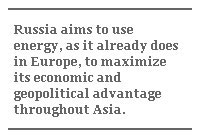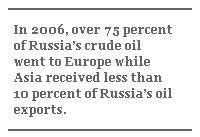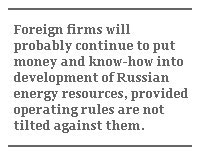Russia Puts Energy Importers Over a Barrel
Russia Puts Energy Importers Over a Barrel

but plans pipelines, like this one in Kovykta, to ship more product to Asia
SINGAPORE: Russia exports more natural gas than any other country and has by far the biggest proven reserves in the world. Much of this so-called “clean” energy is close to Asia, where demand is rising fast for carbon fuels less polluting than coal and oil. Countries are trying to reduce air pollution that harms human health. They’re also under pressure to reduce emissions blamed for warming the planet.
Russia is also the world’s second largest oil exporter, standing number eight in terms of reserves. Yet until recently, little of this energy went to Asia and the Pacific. Instead, for more than 30 years, Russia – and before it, the Soviet Union – sent huge quantities to Europe. Today, Europe depends on Russia for more than a quarter of its gas supply and almost 30 percent of its crude oil imports.

However, the government of Russian President Vladimir Putin seems poised to adjust this energy-export imbalance between Asia and Europe. As it does so, Russia – with about two thirds of its territory in Asia – will gain both economic and political influence, becoming a major player in the region as it is in Europe. Enhancing Russia’s role will be its rejuvenated military power, largely financed by taxes and royalties from the oil and gas sector, which the World Bank says accounts for 20 percent of the country’s GDP, over 60 percent of its export earnings and 30 percent of all foreign direct investment.
A key question is where in Asia and the Pacific will most of the Russian energy go? Russian officials say that China is the biggest potential market, but that Japan, South Korea, India and the US are also targets. Russia aims to use energy, as it already does in Europe, to maximize its economic and geopolitical advantage. For example, Gazprom, the Russian state-controlled gas monopoly, recently warned US energy giant ExxonMobil not to finalize a gas-supply deal with China from a project on Sakhalin Island off the eastern coast of Russia, saying it could upset Russian negotiations with China on pricing and other terms for a bigger long-term gas export deal.

In June, Gazprom said it would take over a giant Siberian gas field belonging to BP and local private-sector investors, for a knockdown price between US $700 million and $900 million. The field at Kovykta in Eastern Siberia is estimated to contain about 2 trillion cubic meters of gas, enough to start supplying China through a pipeline that could be built over the next three years. This would be one of two Russian pipelines, the first carrying 30 billion cubic meters of gas each year to western China and the second 38 billion cubic meters to eastern China. If this gas starts flowing in the next decade, it will be a major addition to Chinese supplies, but still less than half the gas Russia sold to Europe in 2005.
Last year, Russia exported almost 4 million barrels of crude oil per day and around 3 million barrels of oil products per day. Over 75 percent went to Europe and much of the rest to the US. Asia received less than 10 percent of Russia’s oil exports, a far smaller share than Europe. China – East Asia’s biggest importer of Russian oil – bought around 300,000 barrels of oil per day from its neighbor, slightly less than 10 percent of total Chinese crude imports. This oil was shipped to China by rail.
However, Russia is preparing to become a major oil exporter and gas supplier by pipeline to Asia. The government is building a 4,000- kilometer pipeline from Taishet, in Eastern Siberia, to connect with an export terminal at Kozmino Bay, southeast of Nakhodka, a port city overlooking the Sea of Japan. The first stage, scheduled for completion by late next year at a cost of around US $11 billion, will carry oil to Skovorodino, near the border with China. From there, China will finance construction of a spur pipeline, just over 1,000 kilometers, to deliver 300,000 barrels of oil per day deep into its territory, effectively doubling crude-oil imports from Russia.

When completed sometime in the next decade, the Eastern Siberia–Pacific Ocean oil-export pipeline will have a capacity of 1.6 million barrels of oil per day – enabling Russia to ship oil to other markets in energy-short Asia as well as to China. It could also be used to send oil to the US in tankers. Japan, which does not want to see rival China take the lion’s share of Russian energy east of the Ural Mountains, has offered to marshal US $7 billion in loans to help build the pipeline. While the main pipeline will bypass China and run entirely through Russian territory to the Pacific, Beijing doubtless hopes it can negotiate a bigger offtake than 300,000 barrels of oil per day.
Can Russia deliver on its promise to be a reliable long-term, large-scale gas and oil supplier to Asia and the US, as well as Europe? Gazprom is Russia’s biggest company and the world’s largest producer of natural gas, accounting for about 20 percent of global output. The government has charged it with responsibility for coordinating gas, oil and pipeline development in the huge swathe of East Siberian and Far East territory.
However, Gazprom’s gas production has not been rising fast enough in recent years to meet future domestic and foreign demand. Some of its major fields, particularly those in Western Siberia that supply Europe, are aging and in decline. The government forces the firm to sell subsidized gas to domestic users, although these subsidies are due to be phased out by 2013. And Gazprom could use more export pipelines for its gas, especially to Asia. This is being rectified, with more pipelines built for both Europe and Asia.
Russia’s long-established oilfields in Western Siberia, like its major gas fields, are past peak production levels. Output from these oilfields is falling and extraction costs are rising. The most promising areas for new oil production are in Eastern Siberia and on Sakhalin Island. Russian officials say that they can meet foreseeable Asian and US demand from these areas.

But in recent years, as Gazprom and its oil equivalent, Rosneft, have muscled their way back to the commanding heights of Russia’s energy economy, multinational petroleum giants like BP and Shell with substantial assets in the country have been bruised. Before using strong-arm tactics to take a controlling stake from BP and its Russian private-sector partners in the Kovykta gas field in East Siberia last month, Gazprom had used similar high-pressure methods in December to gain a majority share from Shell and a group of Japanese companies in a huge oil and gas project on Sakhalin Island. Will foreign firms continue to put their money, technology and know-how into development of Russian energy resources? Indications are that they will, provided operating rules are not further tilted against them and they are offered access to new reserves on terms they regard as profitable and predictable.
China’s state-owned petroleum companies are also unhappy with Russian terms. Gazprom insists that China pay world-market prices for Russian gas. Meanwhile, China hedges its bets by importing more gas from Southeast Asia, Central Asia, Australia, the Middle East and other non-Russian sources.
If Russia and China agree on a major long-term energy-supply deal, it will consolidate their strategic partnership. If they fail and Russia sends most of its gas and oil instead to Japan, South Korea, the US and other energy-short countries, a power equation less favorable to China will emerge in the region.
Michael Richardson, a former Asia editor of the International Herald Tribune, is an energy specialist at the Institute of South East Asian Studies in Singapore.